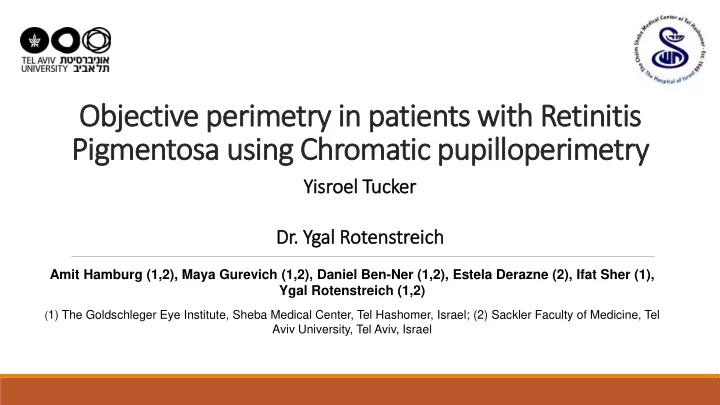

Objective perimetry in patients with Retinitis Pigmentosa using Chromatic pupilloperimetry Yisr isroel Tucker Dr Dr. . Ygal Rotenstreic ich Amit Hamburg (1,2), Maya Gurevich (1,2), Daniel Ben-Ner (1,2), Estela Derazne (2), Ifat Sher (1), Ygal Rotenstreich (1,2) ( 1) The Goldschleger Eye Institute, Sheba Medical Center, Tel Hashomer, Israel; (2) Sackler Faculty of Medicine, Tel Aviv University, Tel Aviv, Israel
Retinitis Pigmentosa A group of inherited disorders characterized by progressive peripheral vision loss. Advanced disease can lead to central vision loss as well. Patients usually don’t notice the initial stages of loss and present later with night blindness and ‘Tunnel vision’. Many genes and different modes of inheritance were identified To date there is no cure for the disease.
Perimetry – Visual field testing Visual field (VF) testing is part of the current clinical standard for evaluating retinal degeneration and optic nerve damage The most common test is Humphrey automated perimetry. The tests is subjective and depends heavily on the patient.
Limitations of subjective perimetry Relies on patient cooperation and attention Affected by patient’s communication skills, attention, fatigue etc. Stressful for patients that need to make conscious decisions in identifying the stimuli. Test-retest variability. In particular in peripheral locations and areas with VF defects.
Perimetry based on pupillary light reflex to focal chromatic stimuli Objective More informative Applicable to various pathologies and patients Cell Type Stimulus Low-intensity red Cones (624nm) Low-intensity blue Rods (485 nm) High intensity blue ipRGCs (485 nm)
OCP – Objective Chromatic Puilloperimeter
Pupillary responses – 15 parameters • PPC - % pupil contraction LMCV • LMCV – Latency of MCV maximal contraction velocity • MCV - Maximal contraction velocity
Aim of the study To perform an objective perimetry in patients with Retinitis Pigmentosa using Chromatic pupilloperimetry. Identify patterns of pupillary response and VF damage in RP patients.
Study design 10 RP patients (2 females & 8 males, age: 41.3± 16.2, mean± SD) 33 healthy age-matched controls were enrolled The pupillary responses of patients were compared with the pupillary responses obtained from controls. Results of patients where also compared with their findings on Humphrey 24-2 perimetry (SITA-STD) and SD-OCT
LMCV in response to red light is more variable in RP patients The Absolute deviation from the median of LMCV is higher in RP patients.
RP patients – Absolute deviation in LMCV in response to red light is significantly higher and more variable in RP patients Vs. control (p=0.000006)
High correlation between chromatic pupilloperimetry red LMCV score and Humphrey MD score 0.6 AVDEV Red LMCV (sec) 0.5 0.4 0.3 0.2 0.1 0 0 -10 -20 -30 -40 MD (Spearman’s rho = 0.709, p=0.22)
High correlation between chromatic pupilloperimetry red LMCV score and SD-OCT ONL volume 0.6 0.5 AVDEV Red LMCV (sec) 0.4 0.3 0.2 0.1 0.0 0 0.1 0.2 0.3 0.4 0.5 ONL Total volume (mm^3) (Spearman’s rho = = -0.817, p=0.004)
GH-based cluster analysis: Identification of RP with high sensitivity & specificity Sector 5 - Red LMCV , AUC=0.971 Garway-Heath sector map
Conclusions The absolute deviation in LMCV in response to red light is significantly higher and more variable in RP patients and may be used a diagnostic marker with high specificity and sensitivity (AUC=0.971). This study demonstrates the potential feasibility of using chromatic pupilloperimetry for objective assessment of VF defects and diagnosis in Retinitis Pigmentosa patients.
Acknowledgements Current Team Past team members Collaborations: Dr. Ygal Rotenstreich Ron Chibel Dr. Alon Skeat, Sheba Medical Center Dr. Ifat Sher Daniel Ben Ner Prof. Michael Belkin, Tel Aviv University Maya Gurevitch Dr. Adi Tzameret Amit Hamburg Dr. Mohamad Mhajna Inbal Sharvit-Ginon Dr. Soad Haj Yahia Ettel Bubis Dr. Asaf Achiron Zehavit Goldberg Dr. Kolker Andrew Zachary Weinerman Dr. Kinori Michael Luba Biniaminov Dr. Attar-Ferman Gili Irina Kriaj Victoria Edelstein Helena Solomon Nir Levy Reham Naserat Sapir Kalish Bubov Kraizman Lori Gueta Funding:
Recommend
More recommend